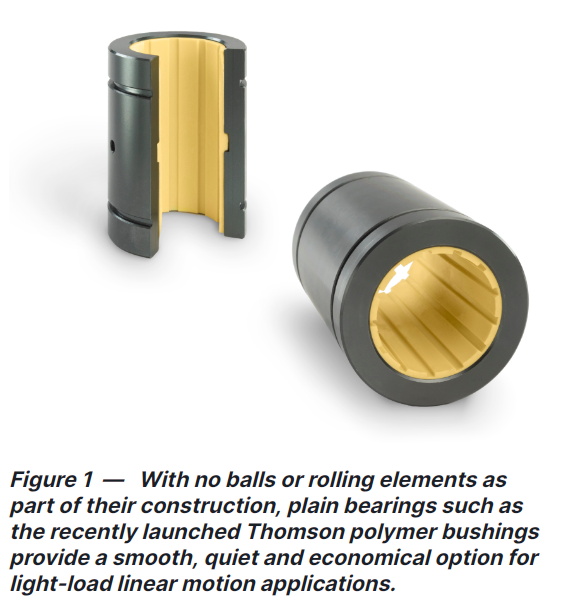Welcome to Sino Bearings web
24x7 HOTLINE:+86-28-81454188

 TECHNOLOGY
TECHNOLOGY
When designing for linear motion systems, the initial decision between round and square rail can significantly impact cost, performance and durability. Square rail, which is typically the more expensive option, has a higher load capacity and tighter accuracy. Round rail offers distinct cost and reliability advantages for certain applications, but maximizing those advantages depends on specifying the right bearing to minimize friction in each application. Designers must often choose between plain bearings — often called bushings — and ball bearings. And within each type, they will have more options that impact price, performance, maintainability and durability. Understanding these options early in the design cycle will optimize the performance and cost of the linear motion application.
Plain and Simple
Because plain bearings have no balls or other rolling elements,they are the least expensive to manufacture and thus cost less. They also out-perform assemblies with rolling elements in terms of smoothness and quietness; and because they have fewer moving parts, they are less susceptible to dust and dirt.
Plain bearings with elastomer liners amplify these benefits. They are available with high-performance, bearing-grade materials applied to aluminum or other substrates to provide good load capacity (20% of that of a ball bearing) and a reasonably low friction coefficient — typically between 0.05 to 0.25.
Since the contact area of a plain bearing is distributed over a large area, plain bearings can also be used with unhardened round shafting, giving designers more flexibility to choose materials that address other design requirements such as corrosion protection or weight.
Some manufacturers make plain bearings from self-lubricating polymers that minimize the need for maintenance. (Fig. 1)
The cost savings and smooth operation of plain bearings, however, come at the cost of load handling, precision, and speed. They are best for applications in which alignment and moment load are noncritical, or those that require shafting that is incompatible with traditional ball bushings such as aluminum or 316 stainless steel. Plain bearings typically handle static loads up to 11,000 lbf, dynamic loads up to 2,023 lbf, and speeds of up to 100 fpm. When those parameters are met, plain bearings — especially those using polymers — are beneficial in both clean and harsh environments. Primary applications involving light loads, lower speed and precision are found in packaging, factory automation, robotics, health and fitness, woodworking, food-and-beverage, and vending. Applications that might also involve ultraclean, toxic or harsh environments include semiconductor production, medical automation and food production.